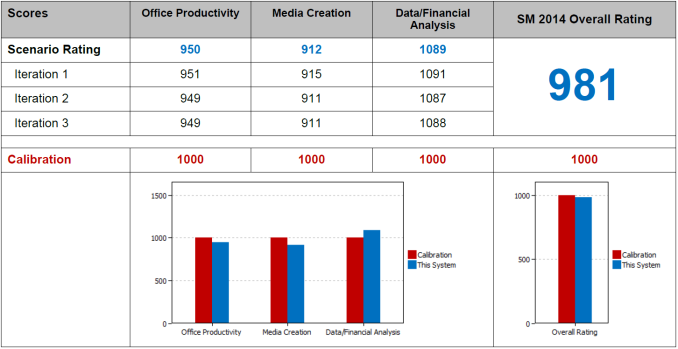Zotac ZBOX CI523 nano Fanless Skylake-U mini-PC Review
by Ganesh T S on October 5, 2016 8:00 AM ESTPerformance Metrics - I
The ZOTAC ZBOX CI523 nano was evaluated using our standard test suite for low power desktops / industrial PCs. Not all benchmarks were processed on all the machines due to updates in our testing procedures. Therefore, the list of PCs in each graph might not be the same. In the first section, we will be looking at SYSmark 2014, as well as some of the Futuremark benchmarks.
BAPCo SYSmark 2014
BAPCo's SYSmark 2014 is an application-based benchmark that uses real-world applications to replay usage patterns of business users in the areas of office productivity, media creation and data/financial analysis. Scores are meant to be compared against a reference desktop (HP ProDesk 600 G1 with a Core i3-4130, 4GB RAM and a 500GB hard drive) that scores 1000 in each of the scenarios. A score of, say, 2000, would imply that the system under test is twice as fast as the reference system.
We have not processed SYSmark 2014 on any of the passively cooled PCs that have been through our review process before. So, we only have the reference system for comparison purposes. It is interesting to see that a Core i3-6100U can almost match a desktop Haswell Core i3 with a much higher TDP
Futuremark PCMark 8
PCMark 8 provides various usage scenarios (home, creative and work) and offers ways to benchmark both baseline (CPU-only) as well as OpenCL accelerated (CPU + GPU) performance. We benchmarked select PCs for the OpenCL accelerated performance in all three usage scenarios. These scores are heavily influenced by the CPU in the system. The CI523 nano with a Skylake-U CPU is easily able to surpass all the other systems based on processors from the earlier generations.



Miscellaneous Futuremark Benchmarks





3D Rendering - CINEBENCH R15
CINEBENCH R15 provides three benchmark modes - OpenGL, single threaded and multi-threaded. Evaluation of select PCs in all three modes provided us the following results. In the CPU-focused benchmark, the Logic Supply ML100G-30 (based on a Broadwell-U Core i5, and having a higher turbo clock) is able to beat the CI523 nano (with a Skylake-U Core i3). However, the GPU improvements from Broadwell to Skylake ensure that the CI523 nano comes out on top in the OpenGL routine.














35 Comments
View All Comments
burningice08 - Thursday, October 6, 2016 - link
One option for single LAN systems is to use a managed switch that supports VLANs. You put your internet on another VLAN and allow both VLANs to the system. Then, on the system you create two virtual NICs, one for each VLAN.jensend - Wednesday, October 5, 2016 - link
Bought one of these, trying to figure out whether to return it based on poor thermal performance and some problems with coil whine. (When silence is the main selling point they ought to be extra careful about coil whine.) Any thoughts on that?Mystified about why the power consumption at the wall is so high compared to competitors.
Any thoughts about how the high temperatures may affect the SSD?
fallaha56 - Wednesday, October 5, 2016 - link
i'd return it -without proper HEVC/HDMI/HDCP what's the point?wolrah - Wednesday, October 5, 2016 - link
"Intel Dual Band Wireless-AC 3165Realtek RTL8168/8111 PCIe Gigabit Ethernet Adapter"
Can someone tell me why they'd spend the money to go Intel for the WiFi but then go with Realtek for the wired side? Intel networking is pretty much the gold standard in the gigabit world. It's not like it's expensive.
Shadowmaster625 - Wednesday, October 5, 2016 - link
You should have used a low power SSD to see what difference it makes.slideruler - Wednesday, October 5, 2016 - link
I have one of those. Running Lubuntu 16.10 beta (16.04 kernel is 4.4 which has halfassed skylake driver)Works fine. On thermal performance: it appears that this zbox was designed for vertical orientation (short side up). That's why there is no holes on the bottom - that's not a bottom (although rubber feet do add to the confusion). I do have some minor coil whining too.
ganeshts - Wednesday, October 5, 2016 - link
Some of the pictures in the marketing collateral do support the vertical orientation. However, placing the unit that way completely blocks one set of the mesh ventilation slots. So, I wasn't comfortable testing it that way.As for coil whine - it is a problem with many of the affordable fanless PCs. FWIW, in the set of 4 first-generation C-series PCs that I evaluated, only one unit had that problem - easily heard when keeping the ears close to the system. My review sample of the CI523 nano didn't have that issue. I think the presence of the issue can vary from one sample to another.
solnyshok - Thursday, October 6, 2016 - link
It is for vertical orientation on VESA mount behind monitor.slideruler - Saturday, October 8, 2016 - link
Ganesh,I've found out why that back panel & SSD were hot. In my case, it was that little USB 3.1 breakout board that was searing hot. After pulling it out (have no use for it anyway), my power draw dropped to 8W. Meaning, USB 3.1 card was pulling 2 watts - a luxury which this tiny, passively cooled PC cannot afford.
Wwhat - Sunday, October 30, 2016 - link
I don't quite get the universal coil whine issue these days, why is that suddenly so much present everywhere? And why don't they just dip the damn coils in lacquer to fix that?